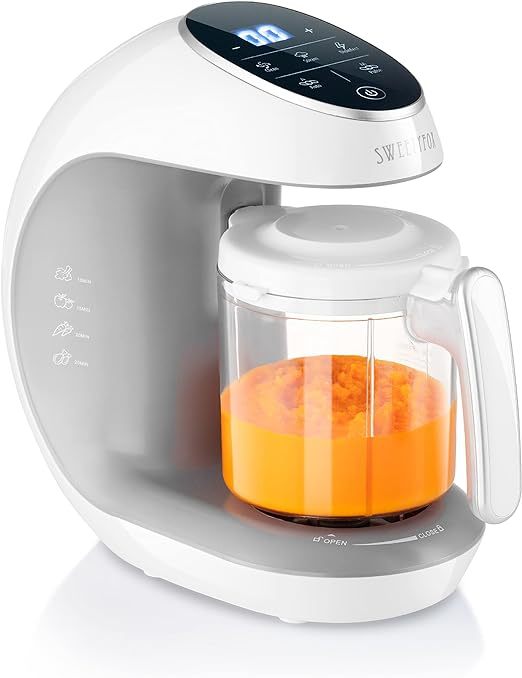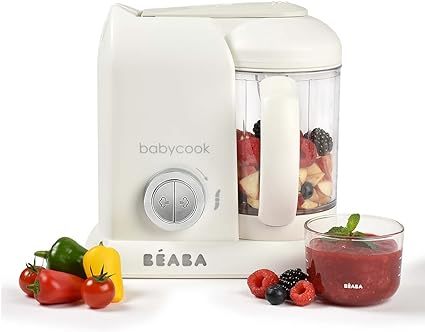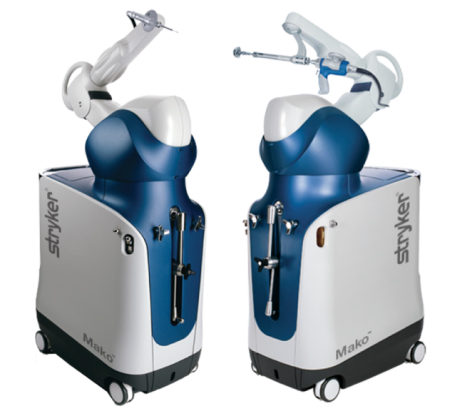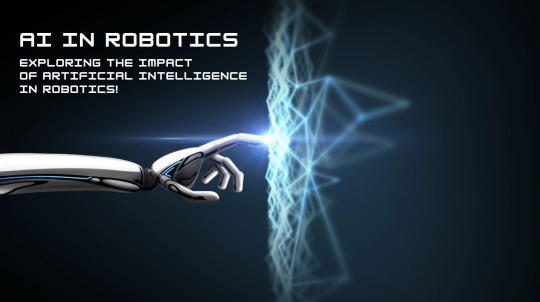#SmartRobot
Explore tagged Tumblr posts
Text
#LINGIXX2#AIrobot#EmotionalAI#SmartRobot#FutureTech#AIInnovation#MachineLearning#AICompanion#TechRevolution#ai latest update#artificial intelligence
0 notes
Text
A cutting-edge AI voice robot with emotional intelligence, designed to understand and respond with natural, expressive interactions. Perfect for smart conversations and personalized experiences.
#AI#SmartRobot#VoiceAI#EmotionalAI#TechInnovation#AICompanion#SmartAssistant#FutureTech#ArtificialIntelligence#AIVoice#ecommerce#meanbuy#international#shopping#global#globalshopping#meanbuyexperience#meanbuyfinds#meanbuyshopping
0 notes
Text
Diversification alimentaire : robot mixeur cuiseur pour bébé

Table des matières
Pourquoi acheter un robot mixeur cuiseur pour bébé ? Qu’est-ce qu’un robot mixeur cuiseur pour bébé ? Comment choisir un robot mixeur cuiseur pour les repas de bébé ? Comment cuire de la viande dans un robot mixeur cuiseur pour bébé ? ConclusionLes principales marques : La diversification alimentaire, un jalon essentiel dans le parcours nutritionnel des bébés, commence généralement vers l'âge de 6 mois. Ce moment marque la transition progressive des nourrissons d'une alimentation exclusivement basée sur le lait maternel ou le lait infantile vers une variété d'aliments solides. L'importance de cette étape réside dans le développement des habitudes alimentaires, du goût, et dans la fourniture de nutriments essentiels pour la croissance du bébé. Le début de la diversification alimentaire coïncide avec une période critique de développement où le lait seul ne suffit plus à répondre aux besoins nutritionnels croissants de l'enfant. Introduire des aliments solides permet d'offrir une gamme plus large de nutriments, notamment des vitamines, des minéraux et des protéines, essentiels pour le développement physique et cognitif du bébé. Faire la diversification alimentaire manuellement peut demander du temps et de l'effort. La préparation minutieuse des aliments, la cuisson, le mixage, et la garantie d'une consistance adaptée peuvent être des tâches chronophages, nécessitant une planification et une exécution méticuleuses de la part des parents. C'est là qu'interviennent les nouveaux robots cuiseurs pour bébé, offrant une simplification appréciable de ce processus. Ces appareils polyvalents intègrent des fonctions de cuisson à la vapeur, de mixage, voire d'autres options pratiques comme la décongélation et le réchauffement. En utilisant un robot cuiseur, les parents peuvent économiser un temps précieux tout en garantissant des repas sains et adaptés aux besoins spécifiques de leur bébé. Les robots cuiseurs pour bébé rendent la diversification alimentaire plus accessible, réduisant le fardeau logistique pour les parents et offrant une solution pratique pour répondre aux exigences nutritionnelles changeantes de leur enfant. En libérant du temps, ces appareils permettent aux parents de se concentrer davantage sur l'interaction avec leur bébé pendant les repas, favorisant ainsi une expérience positive et enrichissante au cours de cette étape fondamentale du développement. Ainsi, les robots cuiseurs pour bébé émergent comme des partenaires précieux pour simplifier le voyage culinaire de chaque nourrisson.

Pourquoi acheter un robot mixeur cuiseur pour bébé ?
Acquérir un robot cuiseur bébé représente une décision judicieuse pour les parents cherchant à assurer une alimentation saine et adaptée à leur tout-petit. Ces appareils simplifient significativement la préparation des repas en combinant des fonctions telles que la cuisson à la vapeur et le mixage, réduisant ainsi le temps et les efforts nécessaires. L'utilisation de ces robots confère aux parents un contrôle absolu sur les ingrédients, éliminant ainsi les additifs et conservateurs fréquemment présents dans les aliments pour bébés du commerce. De plus, la personnalisation des saveurs dès le début de la diversification alimentaire favorise le développement des préférences gustatives du bébé. La capacité d'ajuster la texture des repas selon les besoins alimentaires spécifiques de chaque étape de la croissance offre une adaptabilité précieuse. Les économies à long terme, bien que l'achat initial puisse représenter un investissement, découlent de la préparation de repas faits maison. Les fonctions polyvalentes de certains modèles, incluant la décongélation, le réchauffement et parfois le chauffe-biberon, fournissent une solution complète pour les besoins alimentaires du bébé. De plus, la cuisson à la vapeur préservant les nutriments, l'utilisation d'un robot cuiseur bébé contribue à une alimentation saine et équilibrée, essentielle pour le développement optimal de l'enfant. Enfin, en offrant une préparation rapide et efficace des repas, ces appareils offrent aux parents plus de temps pour s'occuper de leur bébé.
Qu’est-ce qu’un robot mixeur cuiseur pour bébé ?
Un robot cuiseur pour bébé est un appareil électroménager spécialement conçu pour simplifier la préparation des repas destinés aux nourrissons et aux jeunes enfants. Cet équipement polyvalent combine généralement plusieurs fonctions, telles que la cuisson à la vapeur, le mixage, voire d'autres options comme la décongélation et le réchauffement. L'objectif principal d'un robot mixeur cuiseur pour bébé est de permettre aux parents de préparer facilement des repas faits maison, adaptés aux besoins nutritionnels spécifiques des tout-petits. L'utilisation de la cuisson à la vapeur dans ces robots est courante, car elle préserve au mieux les nutriments contenus dans les aliments. Certains modèles offrent également la possibilité de mixer les ingrédients directement après la cuisson, simplifiant ainsi le processus de préparation des purées et des compotes. En résumé, un robot cuiseur pour bébé est un appareil pratique et multifonctionnel qui vise à faciliter la diversification alimentaire en offrant aux parents un moyen efficace de préparer des repas équilibrés, adaptés à l'âge et aux besoins nutritionnels spécifiques de leur enfant. Guide-cadeaux.com
Sélection de cadeaux
Sweety Fox Cuiseur Mixeur

Prix & Descriptif Guide-cadeaux.com
Sélection de cadeaux
Robot Cuiseur Mixeur Bébé

Prix & Descriptif Guide-cadeaux.com
Sélection de cadeaux
BÉABA, Babycook Solo

Prix & Descriptif
Comment choisir un robot mixeur cuiseur pour les repas de bébé ?
Le choix d'un robot multifonction pour les repas de bébé nécessite une considération attentive des besoins spécifiques de l'enfant et des préférences des parents. Voici quelques conseils pour guider cette sélection : - 1. Fonctions essentielles : Optez pour un robot cuiseur pour bébé offrant des fonctions de base telles que la cuisson à la vapeur et le mixage. Ces deux fonctionnalités sont cruciales pour préparer des repas sains et adaptés à l'âge de l'enfant. - 2. Polyvalence : Choisissez un modèle offrant plusieurs fonctions, comme la décongélation, le réchauffement, voire le chauffe-biberon. La polyvalence permet de simplifier davantage la préparation des repas et de répondre à divers besoins nutritionnels. - 3. Capacité et Taille : Assurez-vous que la capacité du robot cuiseur correspond à vos besoins en termes de quantité de nourriture préparée. En outre, considérez la taille de l'appareil pour vous assurer qu'il s'intègre facilement dans votre cuisine. - 4. Facilité d'utilisation : Optez pour un modèle doté d'une interface conviviale et d'instructions simples. Une utilisation intuitive est essentielle, surtout pour les parents occupés. - 5. Entretien : Vérifiez la facilité de nettoyage de l'appareil. Un robot cuiseur avec des pièces amovibles compatibles avec le lave-vaisselle peut être un atout majeur pour gagner du temps. - 6. Sécurité : Assurez-vous que le robot cuiseur pour bébé répond aux normes de sécurité en vigueur. Des dispositifs de sécurité tels que des verrous de sécurité pour le couvercle et une fonction d'arrêt automatique peuvent être des caractéristiques importantes. - 7. Avis et Recommandations : Consultez les avis d'autres parents et des professionnels de la petite enfance pour obtenir des retours d'expérience concrets. Cela peut vous aider à prendre une décision éclairée. - 8. Marque Réputée : Optez pour des marques réputées dans le domaine des robots cuiseurs pour bébés. Les marques bien établies ont souvent une meilleure réputation en termes de qualité et de durabilité. En suivant ces conseils, vous serez mieux équipé pour choisir un robot cuiseur pour bébé qui répondra efficacement à vos besoins et facilitera la préparation des repas pour votre enfant. Guide-cadeaux.com
Sélection de cadeaux
BÉABA Babycook Duo Robot

Prix & Descriptif Guide-cadeaux.com
Sélection de cadeaux
KOSTTE Cuiseur Mixeur Multi.

Prix & Descriptif Guide-cadeaux.com
Sélection de cadeaux
BÉABA - Babycook Néo - Robot Bébé

Prix & Descriptif
Comment cuire de la viande dans un robot mixeur cuiseur pour bébé ?
La cuisson de la viande dans un robot mixeur cuiseur pour bébé peut être réalisée de manière simple et efficace en suivant quelques étapes. Voici un guide général pour cette procédure : 1. Préparation de la Viande : Coupez la viande en petits morceaux, facilitant ainsi la cuisson uniforme et le processus de mixage ultérieur. Il est également recommandé d'ôter tout excès de gras pour obtenir une texture plus fine. 2. Choix du Mode de Cuisson : La plupart des robots mixeurs cuiseurs proposent différents modes de cuisson adaptés à la viande. Les options courantes incluent le mode mijoter, faire rissoler, et le mode cuisson à la vapeur. Sélectionnez le mode approprié en fonction du résultat souhaité. - Mode Mijoter : Utilisez cette méthode pour une cuisson douce à feu doux, idéale pour les viandes tendres qui nécessitent un temps de cuisson prolongé. Elle permet de conserver les arômes et de rendre la viande tendre. - Mode faire rissoler : Optez pour ce mode si vous souhaitez cuire la viande à une température élevée, recouvrant le fond de la cuvette. ce mode est efficace pour sceller les jus et obtenir une surface dorée. - Mode Cuisson à la Vapeur : Utilisez ce mode pour cuire la viande blanche et même le poisson. La cuisson à la vapeur préserve les nutriments et la saveur de la viande. 3. Début de la Cuisson : Placez les morceaux de viande dans le récipient du robot mixeur cuiseur, en veillant à respecter les indications de capacité. Lancez le programme de cuisson approprié en fonction du mode choisi. 4. Surveillance : Pendant la cuisson, surveillez régulièrement pour vous assurer que la viande atteint la cuisson souhaitée. Les temps de cuisson varient en fonction du mode sélectionné et du type de viande. 5. Mixage (si nécessaire) : Certains robots mixeurs cuiseurs offrent la possibilité de mixer automatiquement les aliments après la cuisson dans le même récipient. Si votre appareil ne propose pas cette fonction, retirez la viande cuite et utilisez la fonction de mixage selon les instructions du robot. 6. Vérification de la Cuisson : Assurez-vous que la viande est bien cuite en vérifiant sa texture et sa température interne. La viande doit être tendre, juteuse et atteindre une température interne sécuritaire. En suivant ces étapes, vous pourrez utiliser efficacement un robot mixeur cuiseur pour préparer des plats de viande adaptés aux besoins de votre bébé tout en préservant les nutriments essentiels.
Conclusion
Alors que cette transition peut être chronophage manuellement, l'émergence des robots mixer cuiseurs pour bébé simplifie considérablement le processus. Ces appareils modernes offrent une solution pratique, économisant du temps tout en assurant une alimentation saine. Ils deviennent ainsi des alliés précieux pour les parents, facilitant cette étape fondamentale du développement alimentaire des tout-petits. Les principales marques : Beaba babycook, Babymoov - Nutribaby, KOSTTE Cuiseur Mixeur Vous aimerez aussi : robot mixeur cuiseur famille Read the full article
0 notes
Text
Buy Temi Robot in UAE – Explore Smart Service Robots at Jackys
Looking for an advanced personal or service robot in the UAE? Find the advance Temi Robot at Jacky’s. Ideal for retail, healthcare, education and hospitality, Temi Robot offers autonomous navigation, voice interaction, video calling and smart integrations. Visit Jackys to explore how Temi can improve customer service and automation in your business. For more information, visit https://www.jackys.com/temi-robot/
#TemiRobotUAE#Jackys#ServiceRobot#SmartRobotics#TemiRobot#RobotForBusiness#UAEInnovation#TechInUAE#RoboticsDubai#JackysTechnology#FutureOfWork
0 notes
Text
Empowering Innovation: The Pioneering Spirit of LJ Projects Robotics

In the dynamic world of robotics, where innovation is the cornerstone of progress, LJ Projects Robotics stands out as a beacon of advancement and creativity. Located at the heart of technological development, LJ Projects Robotics is an initiative that not only teaches but also inspires students and professionals alike to explore the endless possibilities in the realm of robotics. You can explore more about their visionary work on their website, LJ Projects Robotics.
Nurturing Future Innovators
LJ Projects Robotics is dedicated to nurturing the next generation of engineers, thinkers, and leaders. Their comprehensive educational programs are designed for a diverse range of participants, from young students just beginning their journey in robotics to advanced professionals looking to enhance their skills. The project's curriculum covers everything from basic mechanics and electronics to sophisticated programming and automation.
A Hands-On Approach to Learning
What sets LJ Projects Robotics apart is its hands-on approach to learning. The organisation believes that true understanding comes from doing. Thus, it provides abundant resources, including state-of-the-art robotics kits, workshops, and interactive sessions that allow learners to apply their knowledge practically. This method not only enhances learning outcomes but also ensures that participants are engaged and motivated throughout their educational journey.
Collaborative Projects and Real-World Applications
At LJ Projects Robotics, education transcends traditional boundaries. The project emphasises the importance of collaborative learning and encourages students to work on group projects. These projects are designed to mimic real-world scenarios, providing students with a taste of what working in the robotics industry entails. Whether it’s designing a robot for agricultural applications or developing automated solutions for healthcare, students are given the opportunity to tackle relevant and impactful challenges.
State-of-the-Art Facilities
To support its cutting-edge curriculum, LJ Projects Robotics boasts state-of-the-art facilities equipped with the latest technologies in robotics and automation. These facilities serve as both a classroom and a laboratory, where ideas can be tested and refined in a controlled environment. The organisation’s commitment to providing top-tier resources underscores its mission to deliver an unparalleled educational experience.
Community Engagement and Outreach
Understanding the importance of community, LJ Projects Robotics extends its impact beyond the classroom through various outreach programs. These initiatives aim to raise awareness about the importance of STEM education and inspire a broader audience to consider careers in robotics. The project participates in community events, hosts open days, and runs demonstrations at schools to ignite interest in robotics and engineering among young students.
Industry Partnerships and Career Development
Recognising the rapid pace of technological advancement, LJ Projects Robotics maintains strong partnerships with leading companies and innovators in the robotics sector. These partnerships not only enhance the quality of the educational programs offered but also provide students with career development opportunities. Internships, job placements, and mentorship programs are just some of the ways in which LJ Projects Robotics prepares its participants for successful careers.
A Commitment to Accessibility
LJ Projects Robotics is committed to making robotics education accessible to all. The organisation offers scholarships and financial aid to ensure that no deserving student is turned away due to financial constraints. This commitment to accessibility reflects the project's broader goal of fostering a diverse and inclusive community of learners and innovators.
Get Involved
For those interested in diving into the world of robotics, there’s no better place to start than LJ Projects Robotics. Whether you are a student eager to learn, a professional aiming to upskill, or a company looking to collaborate, there are numerous ways to get involved. Visit LJ Projects Robotics to discover more about their programs, sign up for workshops, or contribute to their mission of advancing robotics education.
This article highlights the multifaceted programs and initiatives of LJ Projects Robotics, designed to foster an environment of learning and innovation. It invites readers to engage directly through the included hyperlink, encouraging deeper exploration of what LJ Projects Robotics has to offer.
#EmpoweringInnovation#LJProjectsRobotics#PioneeringSpirit#RoboticsRevolution#InnovateWithLJ#TechPioneers#FutureOfRobotics#InnovationLeaders#RoboticsTech#AdvancedRobotics#TechInnovation#BuildTheFuture#RoboticsDevelopment#CuttingEdgeTech#AutomationLeaders#NextGenRobotics#EmpowerTech#RoboticsEngineering#SmartRobotics#InnovativeSolutions
0 notes
Text

Hrithik Kumar and Rohan Chandra, students of BCA at IIMT Group of Colleges in Greater Noida, demonstrated a firefighting robot prototype. They said that lighting, short circuits, and other items frequently cause fires to start in houses and marketplaces. The fire engine takes a long time to arrive in such a case. This leads to more harm. This fire robot is equipped with a motor and a tank. The software will use sensors to locate the location and begin operations as soon as the command is entered. This will assist you in working on a few tasks until the fire engine shows up.
.
#IIMTIndia#IIMTian#IIMTNoida#IIMTGreaterNoida#FirefightingRobot#InnovationInTechnology#BCAStudents#IIMTGroupOfColleges#FireSafety#TechForGood#SmartRobotics#RoboticsInnovation#EmergencyResponse#TechSolutions
0 notes
Text
youtube
Tesla’s 2023 Optimus Robot Unveiled! | Up-Close Look at Tesla Bot in Century City 🚀🤖
Today, I visited the Tesla store at Beverly Hills’ Century City and captured the brand-new 2023 Optimus Robot, also known as the Tesla Bot! Get an exclusive look at Tesla’s latest groundbreaking creation from every angle—front to back, top to bottom. This robot is truly a marvel of technology and design! Join me as I take you up close to explore what could be the future of robotics. Don’t miss this exclusive first-hand footage of the Tesla Bot in action!
#TeslaOptimus#TeslaBot2023#TeslaRobot#FutureOfRobots#CenturyCity#TeslaStore#AI#RobotTech#ElonMusk#FutureTech#TeslaFans#Innovation#BeverlyHills#TechRevolution#Robotics#TeslaAI#ArtificialIntelligence#NextGenRobotics#OptimusRobot#TechInnovation#TeslaTechnology#BeverlyHillsTesla#TeslaExperience#SmartRobots#FutureOfAI#HumanoidRobot#ElonMuskVision#SiliconValleyTech#Robotics2023#AIRevolution
0 notes
Video
Amazing Robot Loading Trucks with Precision! 🤖🚛 | #ArtificialIntelligenc...
#youtube#Robot ArtificialIntelligence AI Logistics Automation FutureTech SmartRobots IndustrialAutomation Innovation
0 notes
Text
What is the future of robotics in the industry and everyday life?
The future of robotics in industry and everyday life is poised for significant evolution:
Industry:
1.Automation: As robotics develops, automation will become more precise and efficient in supply chains, manufacturing, and logistics. 2. Collaboration: Humans and collaborative robots (cobots) will work together to complete hazardous or repetitive activities more productively. 3. Maintenance and Repair: As difficult maintenance and repair jobs become more automated, downtime and operating expenses will be decreased. 4. AI Integration: Better AI will let robots decide more wisely, adjust to shifting conditions, and carry out difficult jobs on their own.
Everyday Life:
1.Personal Assistants: Robots will be used increasingly frequently as companions, helpers with home tasks, and caregivers for the elderly. 2. Healthcare: With robotics, patient outcomes and accessibility will be greatly enhanced in surgery, rehabilitation, and tailored medicine. 3. Transport: The use of autonomous vehicles, such as drones and self-driving automobiles, will revolutionize logistics and transportation while boosting efficiency and safety. 4. Education and Entertainment: Interactive and captivating entertainment options will be provided by robots, which will also improve learning experiences.
#Robotics#IndustrialAutomation#FutureOfWork#AIandRobotics#SmartRobots#Automation#RoboticProcessAutomation#TechInnovation#RoboticsInIndustry
0 notes
Text

#Full Knee Replacement Surgery#knee replacement surgery Ahmedabad#best knee replacement doctor in Ahmedabad#knee joint replacement#knee specialist#Mako SmartRobotics
1 note
·
View note
Text
Revolutionizing Warehouse Operations: The Rise of Autonomous Mobile Robots (AMRs)
The market for Autonomous Mobile Robots (AMRs) has experienced rapid growth in recent years and is projected to continue expanding in the foreseeable future. These versatile robots are finding applications across various industries such as manufacturing, healthcare, warehouse management, logistics, and retail, where they play a crucial role in automating tasks and enhancing operational efficiency. Particularly in the warehouse sector, AMRs have brought about a paradigm shift by revolutionizing the movement and organization of goods within facilities. The widespread adoption of AMRs has led to notable improvements in efficiency, accuracy, safety, and adaptability within warehouses, prompting many operators to integrate them into their logistics strategies. This trend towards greater automation is expected to persist, shaping the future landscape of warehouse operations.
Autonomous Mobile Robots (AMRs) are defined by Quadrant Knowledge Solutions as intelligent machines equipped with an array of sensors, actuators, and software applications enabling them to perceive their surroundings, make informed decisions, and execute tasks without human intervention. These robots collaborate seamlessly with human operators to undertake various responsibilities including goods picking and transportation, facility monitoring and inspection, and providing assistance, all without the need for constant supervision. With continuous advancements in technology, AMRs are becoming increasingly sophisticated, capable of handling more complex tasks and exhibiting decision-making prowess. Their operation relies on a blend of hardware and software technologies, empowering them to autonomously navigate diverse environments and execute a multitude of functions.
The global market for Autonomous Mobile Robots is anticipated to witness a robust compound annual growth rate of 15.5% from 2023 to 2030, reaching a valuation of USD 9.56 billion by the end of the forecast period. The proliferation of warehouse automation initiatives and the widening adoption of AMRs across various industries are key drivers propelling market expansion. These robots excel in navigating challenging terrains autonomously, making them indispensable assets in environments requiring agile and adaptive solutions. Moreover, the adoption of automated material handling practices, including advancements like lights-out automation, further fuels the demand for AMRs, contributing to market growth.
A significant advancement in AMR technology is the integration of self-charging capabilities, which has revolutionized their deployment and management in warehouses and distribution centers. Many vendors now offer self-charging options as an upgrade feature for their AMR solutions, recognizing the pivotal role of this technology in the logistics sector. Self-charging capability addresses the critical need for maximizing uptime and minimizing downtime in warehouse operations, allowing facilities to optimize their processes while reducing labor costs and enhancing overall throughput efficiency. By ensuring continuous operation and minimizing interruptions, self-charging technology enables warehouses to streamline their operations, shorten lead times, and improve overall productivity.
In conclusion, the rapid evolution and adoption of Autonomous Mobile Robots are reshaping the landscape of warehouse operations and logistics management. These versatile machines, equipped with advanced sensors and intelligent software, are driving improvements in efficiency, safety, and flexibility across diverse industries. With the market poised for continued growth, propelled by advancements in technology and the increasing demand for automation, AMRs are poised to play an increasingly integral role in the future of warehouse and logistics operations.
#AutonomousMobileRobots#AMRs#RoboticAutonomy#IntelligentMobileRobots#AutomatedRoboticSystems#AutonomousWarehouseRobots#MobileRoboticSolutions#SmartRobots#AutomatedMobilePlatforms#RoboticAutomationSystems
0 notes
Text
LINGIX X2 AI Robot 🤖✨ – The future of artificial intelligence is here! This cutting-edge AI robot features advanced emotional intelligence, instant learning capabilities, and a futuristic design.
#LINGIXX2#AIrobot#EmotionalAI#SmartRobot#FutureTech#AIInnovation#MachineLearning#AICompanion#TechRevolution#artificial intelligence#ai latest update#ai news#ai revolution#Robotics#ai#latest ai update#ai update
0 notes
Text
AI in Robotics: Exploring the Impact of Artificial Intelligence in Robotics
The fusion of Artificial Intelligence (AI) with robotics marks a significant milestone in the journey towards creating more sophisticated, autonomous machines. This combination, where intelligent software meets advanced hardware, is not just transforming industries but also redefining our understanding of what machines can achieve. As AI in robotics continues to evolve, it's crucial to explore the implications, challenges, and potential of this transformative technology. The integration of AI into robotics is creating entities that are not only capable of performing tasks but also learning, adapting, and making decisions, which opens up a plethora of possibilities across various sectors. This synergy is the driving force behind the next generation of technological advancements, promising to deliver solutions that were once thought to be within the realm of science fiction. At its core, the concept of AI in robotics revolves around imbuing machines with a level of intelligence that allows them to interact with their environment in ways previously exclusive to humans or living creatures. Artificial intelligence robots are being designed to perceive their surroundings, process information, and respond to changes dynamically. This leap in capabilities is what sets these smart robotics systems apart from their predecessors. The integration of AI enables robots to not just follow predefined paths or routines, but to understand and navigate complex, unstructured environments. This transition from programmed machines to intelligent entities represents a significant technological evolution, highlighting the remarkable potential that AI brings to robotics. The significance of AI in robotics extends beyond technical marvels and into practical applications that impact everyday life. From manufacturing floors to research labs, from healthcare to environmental conservation, the applications are vast and varied. These artificial intelligence robots are not just tools; they are partners capable of enhancing productivity, safety, and efficiency. They represent a new era of smart robotics, where machines are not just about automation but are about augmentation. This shift is leading to a re-imagination of processes and systems across industries, paving the way for innovative solutions to longstanding challenges.

Unveiling the Synthesis of AI and Robotics The synthesis of AI and robotics is an exhilarating development in the realm of technology, representing a blend of two cutting-edge fields. AI brings the power of learning, reasoning, and decision-making to robots, enabling them to perform complex tasks with a degree of autonomy that was previously unattainable. This union is not just a linear progression of technological capability but a multiplicative leap forward. The combination of AI's cognitive prowess with the physical capabilities of robots is creating a new class of machines – intelligent, adaptable, and incredibly versatile. These machines are reshaping expectations in robotics, demonstrating abilities that extend well beyond the traditional boundaries of automation. In this synthesis, artificial intelligence robots are being equipped with advanced algorithms that enable them to learn from their experiences, adapt to new scenarios, and make decisions in real-time. This learning capability is a game-changer, allowing robots to improve their performance over time, adapt to varying conditions, and handle unexpected situations with greater proficiency. It’s a transition from robots as mere executors of tasks to entities capable of understanding and evolving. The integration of AI algorithms such as machine learning, neural networks, and computer vision is instrumental in this transformation, making robots not only more autonomous but also more aligned with human-like intelligence and problem-solving capabilities. The implications of smart robotics are profound, with the potential to revolutionize industries and redefine human-machine interaction. These intelligent machines are being designed to work alongside humans, complementing human skills and capabilities. In scenarios where precision, consistency, and endurance are paramount, AI-enhanced robots excel, taking on tasks that are either too dangerous, tedious, or intricate for humans. This collaboration between humans and intelligent machines is opening up new avenues for innovation, driving efficiencies, and fostering a more symbiotic relationship between technology and humanity. The Journey to Intelligent Machines: An Overview The journey towards developing intelligent machines through AI in robotics has been a gradual yet relentless pursuit, marked by significant milestones and breakthroughs. This evolution traces back to the early days of computer science and robotics, where the primary goal was to create machines that could automate repetitive tasks. The initial phase was characterized by robots designed for specific, well-defined functions, often in industrial settings. These robots were efficient but lacked the flexibility and adaptability that come with true intelligence. The real leap began with the integration of AI, which shifted the focus from mere automation to autonomy. The development of AI algorithms capable of learning and evolving played a pivotal role in this transition. As these algorithms became more sophisticated, so did the capabilities of robots. The integration of machine learning, in particular, allowed robots to analyze data, learn from experiences, and make informed decisions. This progression from pre-programmed responses to dynamic decision-making marked a significant step in the journey towards creating truly intelligent machines. In recent years, advancements in sensor technology, computational power, and data processing have accelerated the evolution of AI in robotics. Robots today are equipped with an array of sensors that provide a wealth of information about their environment. This sensory input, combined with advanced data processing capabilities, allows robots to understand and navigate complex environments with a level of precision and autonomy that was previously unimaginable. The integration of technologies like natural language processing and computer vision has further enhanced the intelligence of robots. These technologies enable robots to interact with humans in more natural and intuitive ways, understand and interpret visual information, and operate in diverse and dynamic environments. The culmination of these advancements is a generation of robots that are not just tools but collaborators, capable of contributing to a wide range of tasks and functions in ways that were once the sole domain of humans. Defining Smart Robotics: The AI Revolution Smart robotics, at its essence, is a revolutionary development in the field of robotics, propelled by the integration of AI. This revolution is redefining what robots are capable of, turning them from programmed machines into intelligent entities capable of learning, adapting, and making autonomous decisions. Smart robotics represents a paradigm shift in technology, where the focus is on creating machines that can understand, reason, and interact with their environment in sophisticated ways. This new breed of robots is equipped with AI algorithms that enable them to process vast amounts of data, learn from experiences, and perform tasks with a level of sophistication and autonomy that was previously unattainable. The cornerstone of smart robotics is the ability of these machines to learn and adapt. Through machine learning and deep learning algorithms, robots can analyze data, identify patterns, and make informed decisions based on their learnings. This capability allows them to improve their performance over time, adapting to new tasks and environments with minimal human intervention. It's a significant leap from traditional robotics, where machines performed fixed tasks in controlled environments. Smart robots can operate in dynamic, unstructured settings, making them far more versatile and valuable across various industries. The AI revolution in robotics is also characterized by the integration of advanced sensory and perception technologies. Robots equipped with sensors such as LiDAR, cameras, and tactile sensors can perceive their environment in unprecedented detail. This sensory input, combined with AI-powered processing, enables robots to navigate complex environments, recognize objects, and interact safely and effectively with humans and other objects. This level of perception is crucial for tasks that require a high degree of precision and awareness, from surgical robots in healthcare to autonomous vehicles in transportation. Collaboration between humans and robots is another defining aspect of smart robotics. AI-powered robots are being designed to work alongside humans, complementing human skills and capabilities. This collaboration ranges from cooperative manufacturing where robots and humans work on the same task, to service robots that assist in healthcare, retail, and hospitality. The key is the robots' ability to understand and adapt to human actions and needs, creating a harmonious and productive partnership. Furthermore, the AI revolution in robotics is not just about individual machines but also about systems of robots working together. Through technologies such as swarm intelligence and collaborative robotics, multiple robots can work in unison, coordinating their actions and sharing information. This collective intelligence allows for complex tasks to be completed more efficiently and effectively, showcasing the potential of AI-powered robotics on a larger scale. As this technology continues to advance, the possibilities for smart robotics expand, promising to usher in a new era of innovation and transformation across various sectors and aspects of life.
The Genesis of AI in Robotics
The genesis of AI in robotics can be traced back to the mid-20th century, a period marked by visionary ideas and foundational research in both artificial intelligence and robotics. The dream was to create machines that could mimic human intelligence and behavior, a pursuit that initially seemed like science fiction. The early stages involved basic robots programmed to perform simple tasks. The introduction of AI in this field, however, was a groundbreaking step that began to transform these simple machines into intelligent entities. The initial experiments in AI were focused on enabling machines to solve problems, learn from data, and interpret their environment. This phase laid the groundwork for the sophisticated AI algorithms we see in today's robots. As technology advanced, so did the ambitions and capabilities in the field of AI in robotics. Key developments in computer science, particularly in areas like machine learning and neural networks, opened up new possibilities for robotic intelligence. The 1980s and 1990s saw significant strides in both hardware and software, leading to robots that were not only more physically capable but also beginning to exhibit rudimentary forms of intelligence. These machines started to learn from their experiences, adapt to new inputs, and perform tasks with greater autonomy. This period marked the transition from robots as mere tools to robots as agents capable of independent decision-making. The early 21st century witnessed an acceleration in the integration of AI into robotics, driven by leaps in computational power, sensor technology, and data analytics. This era saw the emergence of robots capable of complex tasks and decision-making processes, powered by advanced AI algorithms. Robotics began to move out of controlled industrial environments and into more dynamic spaces, like homes, streets, and skies. This shift not only demonstrated the technological advancements but also highlighted the vast potential of AI-enhanced robotics in transforming everyday life and various industries. From Automated to Intelligent: The Evolution of Robotics The evolution of robotics from automated machines to intelligent entities is a testament to the incredible advancements in technology and engineering. The journey began with the creation of automated machines designed to perform specific, repetitive tasks. These early robots were revolutionary in their time, increasing efficiency and safety in industries like manufacturing and automotive assembly. They followed pre-programmed instructions and operated in structured environments. However, their capabilities were limited to the tasks they were explicitly designed for, with no ability to adapt or learn from their experiences. The introduction of AI into robotics marked the beginning of a new era. Robots equipped with AI algorithms could interpret data, learn from their environment, and make decisions based on this learning. This shift was significant; robots were no longer just following instructions, but were beginning to understand and interact with their surroundings. The incorporation of machine learning and artificial neural networks played a crucial role in this evolution. These technologies enabled robots to process vast amounts of data, identify patterns, and adapt their behavior over time. As AI technologies advanced, so did the sophistication of robots. The 2000s and beyond witnessed the development of robots with enhanced sensory capabilities, advanced data processing, and improved physical agility. These robots could navigate unstructured environments, recognize objects and people, and perform complex tasks with a higher degree of autonomy. The integration of technologies like computer vision, natural language processing, and context-aware computing further enhanced their intelligence, making them more adaptable and capable of handling a broader range of tasks. Today, the evolution continues with the development of robots that are not just intelligent but also capable of collaborating and learning in tandem with humans. These advanced robots are being integrated into various aspects of daily life, extending their influence beyond industrial applications to healthcare, service industries, and personal assistance. This ongoing evolution from automated to intelligent systems in robotics is not just enhancing machine capabilities but is also redefining the role of robots in society and industry. Key Milestones in AI Robotics: A Historical Perspective The historical journey of AI in robotics is marked by several key milestones that have significantly shaped its development. One of the earliest milestones was the development of the Stanford Arm in the 1960s, a robotic arm that represented a leap in robotic manipulation and control. This innovation laid the foundation for subsequent robotic arms used in manufacturing and assembly lines. Another landmark event in the 1970s was the creation of WABOT-1, the first full-scale humanoid robot capable of walking and basic interaction, symbolizing the potential of more human-like robots. The 1990s and early 2000s witnessed a surge in AI capabilities, which fueled significant advancements in robotics. A notable milestone during this period was the development of ASIMO, a humanoid robot by Honda, which demonstrated advanced bipedal motion and interaction capabilities. This era also saw the advent of robotic vacuum cleaners like the Roomba, bringing robotics into everyday household use and showcasing the potential of autonomous machines in personal environments. Another significant milestone was the DARPA Grand Challenge in the 2000s, which spurred advancements in autonomous vehicles. This competition pushed the boundaries of AI and robotics, leading to the development of self-driving cars that combined robotics, AI, and advanced sensor technology. These events collectively marked crucial phases in the journey of AI in robotics, each contributing to the field's growth and paving the way for future innovations. The Convergence of AI and Robotics: A Synergy Unlocked The convergence of AI and robotics represents a synergy that has unlocked new possibilities and frontiers in technology. This merging of fields has led to the creation of robots that are not only physically capable but also intellectually adept. AI brings a layer of cognitive intelligence to robotics, enabling machines to process information, learn from experiences, and make autonomous decisions. This integration has transformed robots from being purely mechanical entities to intelligent agents capable of complex behaviors and tasks. This synergy is evident in the way robots can now perceive their environment. With AI, robots are equipped with advanced vision systems, auditory processing capabilities, and tactile sensors that allow them to understand and interact with their surroundings in much more nuanced ways. These sensory inputs, processed through AI algorithms, enable robots to navigate complex environments, recognize objects and faces, and perform tasks with a high degree of precision and autonomy. Another aspect of this convergence is the enhancement of robots' decision-making and problem-solving abilities. AI algorithms, particularly those based on machine learning and deep learning, empower robots to analyze data, identify patterns, and make informed decisions. This capability is crucial in applications like autonomous vehicles, where split-second decisions can have significant implications. The ability of robots to learn from their experiences and improve over time is another hallmark of this synergy, leading to increasingly sophisticated and capable robotic systems. Furthermore, the integration of AI has expanded the applications of robotics into domains that were previously inaccessible. From medical surgeries performed with robotic precision to exploration robots in space and deep-sea environments, the convergence of AI and robotics is pushing the boundaries of what machines can achieve. This synergy is not only enhancing the capabilities of robots but is also creating opportunities for innovation and advancements across various fields and industries. How AI is Redefining Robotics: Core Principles and Technologies AI is redefining the field of robotics through several core principles and technologies. At the heart of this transformation is machine learning, a branch of AI that enables robots to learn from data and experiences. Machine learning algorithms allow robots to recognize patterns, adapt to new scenarios, and improve their performance over time. This adaptability is crucial in dynamic environments where robots must respond to changing conditions and unforeseen challenges. Deep learning, a subset of machine learning, further enhances the capabilities of robots. By utilizing artificial neural networks, deep learning enables robots to process and interpret complex data inputs such as images, sound, and tactile sensations. This technology is integral in developing advanced vision systems for robots, allowing them to identify objects, navigate spaces, and perform tasks with a high level of precision. Natural language processing (NLP) is another AI technology reshaping robotics. Read the full article
#AIandIoT#AIinrobotics#AIroboticsintegration#AI-drivenrobots#artificialintelligencerobots#ethicalAIinrobotics.#humanoidrobots#quantumcomputingrobotics#roboticintelligence#smartrobotics
0 notes
Text
youtube
Top 15 Humanoid Robots Coming For Sale In 2025
Humanoid Robot For Sale is not just a phrase—it's a reality in 2025! This groundbreaking video reveals the latest innovation in personal robotics.
website: https://www.futurobots.com/humanoid-robot-for-sale/
HumanoidRobot #RobotForSale #AItechnology #FutureOfAI #SmartRobot #Robotics2025 #TechGadgets #ArtificialIntelligence #HomeRobot #NextGenRobots
humanoid robot, robot for sale, ai, a.i., artificial intelligence, tesla bot, tesla optimus, atlas, boston dynamics, android, neo, unitree, apptronik, g1, 1x, apollo, artificial general intelligence, asi, agi, neural network, deep learning, machine learning, natural language processing, reinforcement learning, chatgpt, openai, robot news, ai news, technology news, future technology, tech breakdown, high tech, ai robot for home, personal assistant robot, smart robot, robot that talks, robot that cleans, home automation robot, robot with voice, robot with human face, robot assistant, robotics for home, buy humanoid robot, advanced humanoid robot, futuristic robots, robot innovation, lifelike humanoid robot, real humanoid robot, affordable robot, trending robots 2025, latest tech gadgets, futuristic home gadgets, top robot 2025, robot like human, robot for seniors, intelligent robot assistant, ai tech for homes, elon musk
0 notes
Text
Choosing Robotic Total Knee Replacement Surgery in Delhi for Better Recovery
Knee pain is a growing concern among people of all ages, particularly those suffering from arthritis, injury-related damage, or age-related wear and tear. Traditional treatment methods, though helpful in early stages, often fall short for advanced cases where mobility is severely restricted. Fortunately, innovations in orthopedic surgery have introduced robotic-assisted techniques that are redefining recovery outcomes. One such groundbreaking advancement is Robotic Total Knee Replacement Surgery in Delhi, which is now widely recognized for offering superior precision, minimal pain, and faster recovery.
Delhi, with its advanced healthcare infrastructure and experienced surgeons, is at the forefront of this medical evolution. In this comprehensive blog, we explore why patients are increasingly choosing Robotic Knee Replacement in Delhi and how this decision leads to better post-operative recovery. We will also guide you on selecting the Best Robotic Knee Replacement Surgeon in Delhi NCR for optimal results.
Understanding Robotic Total Knee Replacement Surgery
Robotic Total Knee Replacement Surgery is a state-of-the-art procedure where a robotic system assists the orthopedic surgeon in replacing a damaged knee joint. This technology enhances surgical precision through 3D mapping and real-time analytics, allowing the surgeon to position the implant with sub-millimeter accuracy.
The robotic system does not operate independently but acts as a highly accurate tool in the hands of a skilled surgeon. The benefits of Robotic Knee Replacement Surgery in Delhi India extend beyond precision—they directly influence how quickly and comfortably a patient recovers after surgery.
Why Choose Robotic Knee Replacement in Delhi?
Robotic Knee Replacement in Delhi is gaining popularity for many reasons. Patients now seek treatment options that not only address the root cause of their condition but also help them return to their normal lives quickly. Here's why Delhi is a preferred location:
1. Advanced Robotic Systems
Hospitals in Delhi use cutting-edge technology like Mako SmartRobotics and ROSA Knee System that offer unparalleled precision during surgery.
2. Experienced Surgeons
The city is home to renowned Robotic Knee Replacement Surgeons in Delhi who are trained in both traditional and robotic procedures. Their experience ensures that patients get the best of both worlds—clinical expertise combined with technological support.
3. Comprehensive Care
From preoperative planning to post-surgical rehabilitation, Delhi hospitals provide end-to-end care tailored to the individual needs of each patient.
Faster Recovery with Robotic Total Knee Replacement Surgery
One of the most significant advantages of Robotic Total Knee Replacement Surgery in Delhi is the improved recovery rate. Compared to traditional knee replacement, robotic surgery results in:
✅ Smaller Incisions
The robotic approach requires smaller cuts, which means less trauma to surrounding tissues. This results in reduced blood loss, quicker wound healing, and a lower risk of infections.
✅ Precise Implant Placement
Correct placement of the implant leads to more natural knee movement, reduced wear and tear, and better long-term joint performance. This precision also means fewer complications and less likelihood of revision surgery.
✅ Reduced Pain and Inflammation
Minimized tissue damage during surgery results in less pain and inflammation post-operation. Many patients are able to walk with assistance within 24 hours.
✅ Shorter Hospital Stay
Due to faster recovery, patients can often return home within 3–4 days of surgery and resume their daily routines in a matter of weeks.
Who Should Consider Robotic Knee Replacement?
Robotic Knee Replacement in Delhi is suitable for patients with:
Severe osteoarthritis or rheumatoid arthritis
Chronic knee pain affecting daily activities
Knee deformities or previous joint trauma
Failure to respond to conservative treatments like medication and physiotherapy
Your orthopedic surgeon will assess your condition to determine whether robotic surgery is the most appropriate option.
Finding the Best Robotic Knee Replacement Surgeon in Delhi NCR
Choosing the Best Robotic Knee Replacement Surgeon in Delhi NCR can greatly impact the outcome of your surgery. Here's what to look for:
🔹 Credentials and Training
Ensure the surgeon is board-certified and has received specialized training in robotic-assisted knee replacement.
🔹 Surgical Experience
Surgeons who have performed a large number of robotic knee replacements are likely to offer better outcomes and fewer complications.
🔹 Patient Reviews and Testimonials
Genuine feedback from past patients can provide insights into the surgeon’s expertise, bedside manner, and overall care approach.
🔹 Hospital Affiliation
Check whether the surgeon is affiliated with a hospital equipped with advanced robotic systems and a reputation for excellence in orthopedic care.
The Role of Technology in Robotic Knee Replacement Surgery
Technology is the backbone of robotic surgery. The process typically involves:
Preoperative Planning A CT scan or digital X-ray is taken to create a 3D model of your knee. This model helps the surgeon plan the precise size, position, and alignment of the implant.
Intraoperative Guidance During the surgery, the robotic system provides real-time feedback to guide the surgeon's instruments. It ensures the removal of only the damaged bone while preserving healthy tissues.
Precision Execution The robotic arm assists the surgeon in executing the surgical plan with unmatched accuracy, reducing the chance of human error.
This advanced integration of technology ensures that Robotic Knee Replacement Surgery in Delhi, India is not just a trend but a proven approach to improving surgical outcomes and speeding up recovery.
Cost and Accessibility
While robotic surgery may appear more expensive upfront due to the use of advanced equipment, it is often more cost-effective in the long run. Faster recovery means less time away from work, reduced physiotherapy needs, and a lower chance of revision surgery.
Many top hospitals in Delhi offer competitive pricing, EMI plans, and insurance support. Additionally, Delhi is a well-connected city, making it accessible for patients from across India and abroad.
Post-Surgery Recovery and Rehabilitation
The road to full recovery begins immediately after surgery. Here's what to expect:
Day 1–2: Walking with assistance begins, and mild physiotherapy is initiated.
Week 1–2: Pain subsides significantly, and patients can walk longer distances with or without support.
Week 3–6: Patients regain better range of motion and strength in the operated knee.
Month 2–3: Return to most routine activities, including walking, light exercise, and climbing stairs.
Patients who opt for Robotic Total Knee Replacement Surgery in Delhi often report high satisfaction due to minimal discomfort and rapid improvement in mobility.
Why Patients Prefer the Best Robotic Knee Replacement in Delhi?
Delhi offers a unique combination of technology, affordability, and expert care. Whether you are a local resident or traveling from another part of India or abroad, you’ll benefit from:
Personalized Treatment Plans
High surgical success rates
World-class robotic systems
Experienced support teams
This is why the capital remains the top choice for those seeking the Best Robotic Knee Replacement in Delhi.
Common Questions About Robotic Knee Surgery
❓ Is robotic surgery safe?
Yes. Robotic surgery is FDA-approved and performed by trained orthopedic surgeons using advanced technology to ensure precision and safety.
❓ Is recovery faster than traditional surgery?
Absolutely. Patients experience less pain, quicker mobility, and reduced hospital stays compared to conventional methods.
❓ Will the robot perform the surgery?
No. The robot assists the surgeon, but all decisions and movements are made and controlled by the surgeon.
❓ Is it suitable for elderly patients?
Yes, provided they are medically fit. Robotic surgery is particularly beneficial for elderly patients due to its minimally invasive nature and faster recovery.
Conclusion
Making the decision to undergo Robotic Total Knee Replacement Surgery in Delhi can be life-changing. Whether you're struggling with persistent knee pain or limited mobility, this advanced procedure offers a path to recovery that is faster, safer, and more effective than traditional methods.
However, your choice of surgeon and hospital is critical to ensuring success. Selecting the Best Robotic Knee Replacement Surgeon in Delhi NCR ensures you benefit from the full potential of robotic technology. With the right team by your side, Robotic Knee Replacement Surgery in Delhi India can restore your mobility, eliminate your pain, and give you a new lease on life.
#Best Robotic Knee Replacement Surgeon in Delhi NCR#Robotic Knee Replacement Surgery in Delhi#India#Robotic Total Knee Replacement Surgery in Delhi#Robotic Knee Replacement Surgeons in Delhi#Best Robotic Knee Replacement in Delhi#Robotic Knee Replacement in Delhi
0 notes
Text
Helix AI: The Smartest Humanoid Robot Ever Built – A Revolutionary Leap in Robotics
🚀 The Future is Here! Meet Helix AI, the most advanced humanoid robot ever built! 🤖 With cutting-edge vision, language, and adaptive intelligence, this AI powerhouse is redefining home automation and robotics. Experts are calling it a game-changer! 🌍✨ #AI #HelixAI #SmartRobots #FutureOfTech #ArtificialIntelligence #Robotics #HomeAutomation #Innovation
The world of robotics has taken a giant leap forward with the introduction of Helix AI, a revolutionary humanoid robot developed by Figure. Unlike traditional robots that rely on extensive pre-programming, Helix AI demonstrates an unprecedented level of adaptive intelligence, allowing it to interact and respond to its surroundings seamlessly. This breakthrough comes after Figure’s strategic shift…
#Adaptive AI#AI in Home Automation#AI-Powered Robot#Artificial Intelligence#Figure AI Robot#Future of Robotics#Helix AI#Smartest AI Robot
0 notes